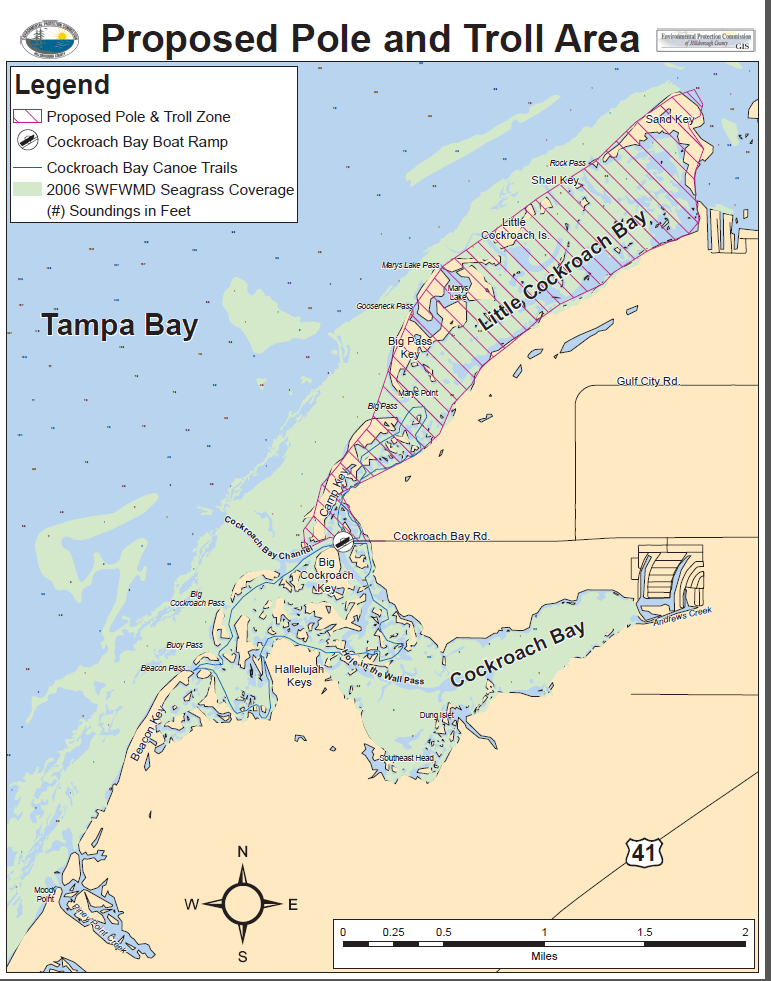A proposed “pole and troll,” or no-motor zone, for Little Cockroach Bay near Ruskin has generated considerable controversy, but the idea seems to be gaining favor among anglers if running lanes can be established to allow quicker access to interior fishing grounds.
Seagrass beds in Little Cockroach Bay have sustained heavy damage from boats barreling through the shallow flats, prompting the proposal by Hillsborough County’s Environmental Protection Commission to bar high-speed traffic there. Scientists have documented upwards of 15,000 prop scars, some as long as 200-feet.
“It represents everything from ‘Oops, I ran aground’ to ‘I’m just gonna’ keep plowing through until I get to deeper water,” says EPC Environmental Manager Tom Ash.

The pole and troll zone would encompass all waters inside the mangrove islands from the Cockroach Bay boat ramp to the Little Manatee River. The county would monitor seagrass recovery for a period of five years before reevaluating management options.
In Ruskin, a public meeting to discuss the proposal in late May turned out a standing-room only crowd. While some objected to the restriction, others endorsed the idea, at least in principle. Florida Guides Association spokesperson Capt. Danny Guarino said the group supports a pole and troll zone as long as there is reasonable access for the public.
Fishing guide Wade Osborne spoke in favor of the proposal. “I have a captain’s license but I don’t have any more right than anyone else to destroy seagrass habitat,” he said. Others like long-time commercial crabber Gus Muench would like to see the entire Cockroach Bay Preserve off-limits to combustible
engines.
Seagrass advocates worry that the plan may mean little without adequate enforcement. The Florida Fish and Wildlife Conservation Commission (FWCC) has just eight environmental enforcement officers in Hillsborough County patrolling county lands, rivers and the bay. “It’s a huge issue,” says Richard Sullivan, who manages the county portion of the state preserve. “These guys do a great job, but there are too few bodies.”
EPC is soliciting public input into the plan and has formed a task force of recreational boaters and anglers to review the proposal. At an organizational meeting in June, participants were given maps of the area to mark up with suggestions. Fishing guides want an existing slow-speed manatee protection zone moved landward from the six-foot contour line, which starts a mile offshore in places, lengthening considerably the time it takes to reach prime fishing flats. If that can’t be accomplished, they advocate creating high-speed access routes through natural sloughs in the sandbar, which separates the open water from the flats, up to a pole and troll zone.
Although the manatee protection zones are county-mandated, any proposed changes would require approval from the state. FWCC biologist and task force member Scott Calleson says the agency is open to suggestions, but any modification would first entail fully evaluating the data to ensure that manatees are adequately protected.
While EPC will submit its draft seagrass management plan for Tampa Bay to the county commission this summer, a final proposal on protection zones at Little Cockroach Bay isn’t expected before Fall, after the task force has considered various options.
Still, as participants debate the details, most fishermen agree that slowing boat traffic will ultimately benefit anglers. “It’s not a superhighway,” says fishing guide Bryon Chamberlin. “You have to work to get into these areas, but you know what, the fishing will be better too.”
To view the complete seagrass management plan for Tampa Bay, go to www.epchc.org.
Article originally published Summer 2007. The 2007 proposal ultimately failed but other efforts to protect the seagrasses continue.
